Da Vinci’s The Last Supper is one of the most renowned masterpieces of all time. It has captured the imagination of countless individuals, from art enthusiasts to conspiracy theorists, and has spawned numerous interpretations and analyses. However, one aspect that has often been overlooked is the presence of Masonic symbols within the painting.
Freemasonry is one of the oldest and most influential fraternal organizations in the world, with a rich history and tradition that spans centuries. At the heart of this ancient and venerable institution lies a complex system of symbols and allegories that communicate profound truths about the nature of reality, the purpose of existence, and the path to enlightenment.
The Last Supper is replete with hidden messages and esoteric symbols that only those with a keen understanding of Masonic principles and symbolism can decipher. In this article, we will explore the top 13 hidden Masonic secrets within The Last Supper.
1. The Letter “G” – God, Geometry, and the Great Architect of the Universe
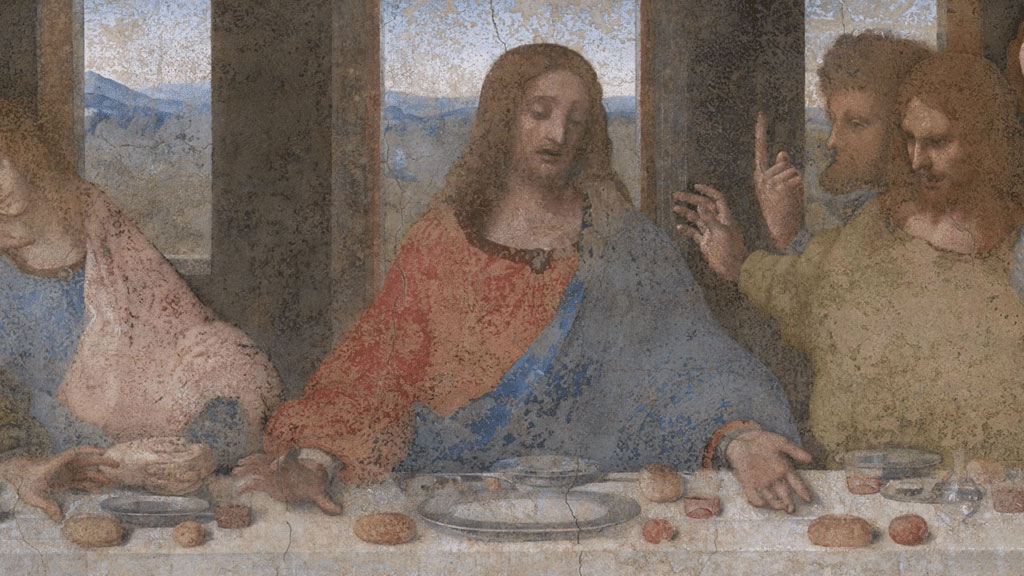
The Letter “G” is a subtle but significant symbol in Freemasonry, representing various meanings such as God, Geometry, and the Great Architect of the Universe. In The Last Supper painting, the letter “G” can be found on the forehead of Jesus, which is believed to be a nod to Masonic influences.
For Masons, the letter “G” is a reminder of the importance of both faith and reason, with God representing the spiritual aspect of life, while Geometry symbolizes the rational and logical aspect. Together, they represent the harmony between the spiritual and material worlds. The Great Architect of the Universe is an all-encompassing term that Masons use to refer to the divine force that created and governs the universe.
In The Last Supper, the presence of the letter “G” on the forehead of Jesus serves as a reminder of the divine presence and influence in the world, as well as the importance of the principles of faith and reason in Masonic teachings. The placement of the letter on Jesus’ forehead also highlights his significance as a spiritual leader and a representative of God on Earth.
Overall, the letter “G” in Masonic symbolism represents a complex and nuanced understanding of the relationship between the spiritual and rational aspects of life, as well as the presence of a divine force that governs the universe. Its presence in The Last Supper painting further emphasizes the connection between Masonic teachings and Christian symbolism.
2. The All-Seeing Eye – The Eye of Providence and the Illuminated Mind
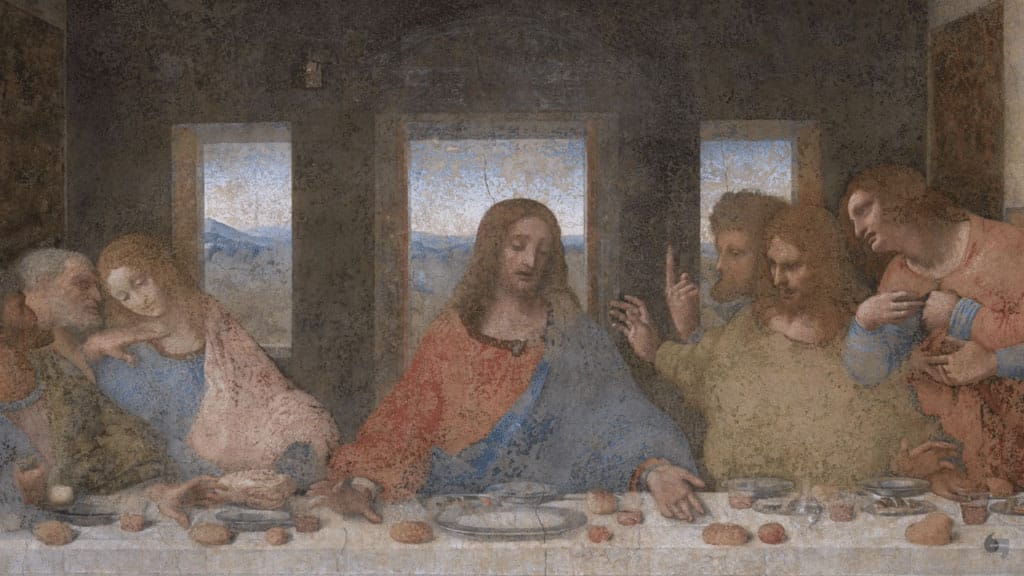
The All-Seeing Eye is a symbol that has been used by many cultures and organizations throughout history, including Freemasonry. It is often associated with the Eye of Providence, which is a symbol of God’s omniscience and watchful gaze over humanity. In Masonic teachings, the All-Seeing Eye represents the illuminated or enlightened mind, and the pursuit of knowledge and truth.
The All-Seeing Eye is another iconic Masonic symbol, representing the watchful gaze of the Great Architect and the illuminated mind of the initiate. But it is also a symbol of divine providence, reminding Masons of their duty to uphold justice and righteousness in the world.
One of the most prominent Masonic symbols in The Last Supper is the all-seeing eye, which can be seen above the window above Jesus’ head. This symbol is associated with the concept of divine providence and is commonly used in Masonic lodges and symbolism.
In The Last Supper, the All-Seeing Eye can be seen in the background of the painting. The window is positioned directly above the head of Jesus, with the light shining down on him, suggesting that he is being watched over by a higher power.
Some interpretations suggest that the presence of the All-Seeing Eye in the painting represents the idea that Jesus was a prophet who had been granted divine knowledge and insight. Others see it as a representation of the Masonic belief in the pursuit of knowledge and enlightenment.
Regardless of the interpretation, the All-Seeing Eye remains a powerful symbol that has captivated the imaginations of people for centuries. Its presence in The Last Supper adds another layer of mystery and intrigue to this already fascinating work of art.
3. The Number 3 – The Trinity, the Triad, and the Three Degrees of Masonry
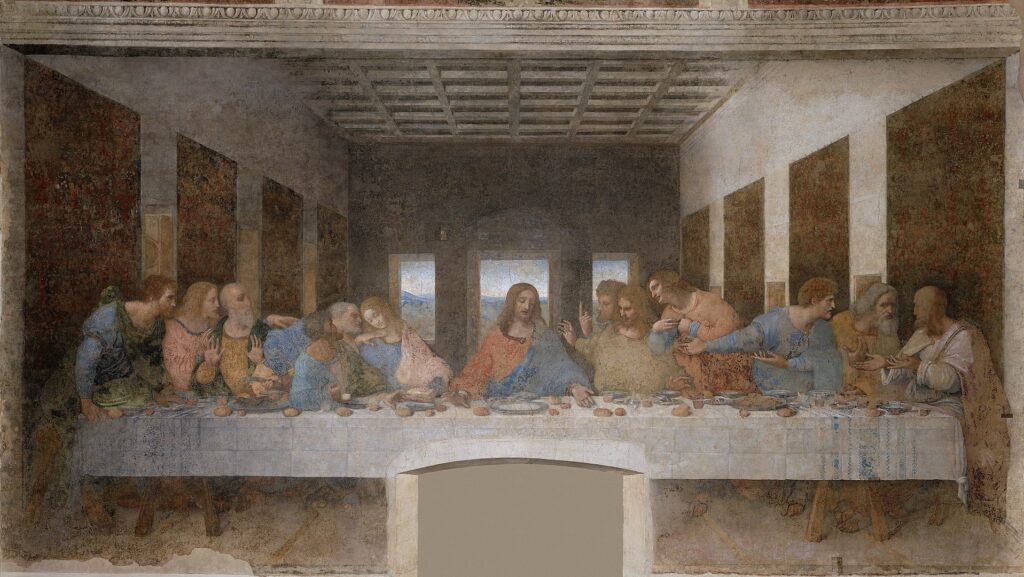
The number 3 holds a special place in Masonic symbolism, representing the Trinity, the Triad, and the Three Degrees of Masonry. It also embodies the principle of balance and harmony, as reflected in the three pillars of the Lodge. In this section, we will delve into the multiple layers of meaning behind the number 3 and its role in Masonic ritual and symbolism.
In Freemasonry, the journey towards becoming a Master Mason involves passing through three degrees of initiation: Entered Apprentice, Fellow Craft, and Master Mason. Each degree represents a different stage in the Masonic journey, with its own set of teachings and symbols.
- The first degree, Entered Apprentice, is focused on the concept of initiation and represents the beginning of the Masonic journey. It teaches the candidate about the importance of self-improvement and emphasizes the virtues of faith, hope, and charity. The symbols of this degree include the working tools of the Entered Apprentice, such as the square, level, and plumb, which are used to teach the candidate about the importance of moral and ethical conduct.
- The second degree, Fellow Craft, builds on the teachings of the first degree and is focused on the pursuit of knowledge and education. It emphasizes the importance of cultivating the mind and encourages the candidate to continue their journey of self-improvement through the pursuit of learning. The symbols of this degree include the working tools of the Fellow Craft, such as the square, level, and plumb, as well as the compass and the trowel, which are used to teach the candidate about the importance of balance, precision, and harmony in all aspects of life.
- The third and final degree, Master Mason, is the culmination of the Masonic journey and represents the attainment of wisdom and spiritual enlightenment. It teaches the candidate about the importance of service, sacrifice, and brotherhood, and emphasizes the value of living a life of integrity and honor. The symbols of this degree include the working tools of the Master Mason, such as the square, level, and plumb, as well as the trowel, the gavel, and the Masonic apron, which are used to teach the candidate about the importance of service, leadership, and selflessness.
33133 – In this painting, there are two groups of three disciples on either side of Jesus, with Jesus sitting in the center, for a total of thirteen figures. Each group of three disciples appears to be reacting differently to Jesus’ announcement that one of them will betray him.
It also corresponds to the thirty-three degrees of Masonry, with the highest degree being the 33rd degree. In The Last Supper painting, there are several references to the number three, such as the three windows in the background and the three loaves of bread on the table.
This arrangement of the disciples is believed to be significant and symbolic, as it mirrors the traditional Christian imagery of the Holy Trinity. The number three is also significant in Christianity, representing the Father, Son, and Holy Spirit. In addition, the number thirteen has been associated with bad luck or betrayal in some cultures and traditions, which may be why Jesus’ announcement of betrayal is made to a group of thirteen individuals.
4. The Triangle – The Holy Trinity, the Pythagorean Theorem, and the Triple Tau
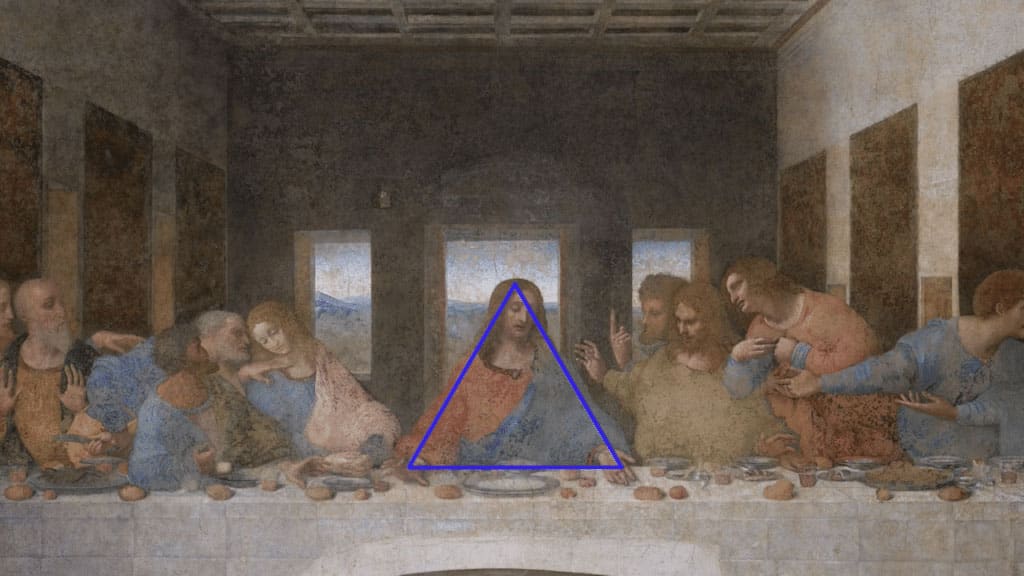
The triangle is a fundamental shape in geometry, and it holds great significance in many cultures and traditions. In The Last Supper painting, the triangle is used as a symbol of divinity and perfection, reflecting its importance in Masonic teachings.
One of the most prominent instances of the triangle in the painting is the composition of the figures themselves. Jesus is positioned at the apex of an invisible triangle, with his arms stretched outwards, forming the base of the triangle. This triangular composition not only adds balance and harmony to the painting but also suggests that Jesus is the divine center of the scene.
Furthermore, the triangle represents the Holy Trinity in Christian beliefs, comprising the Father, Son, and Holy Spirit. This trinity is reflected in the three windows in the background of the painting, symbolizing the divine presence and the unity of the three persons in one God.
In addition to its religious connotations, the triangle also has mathematical significance, as seen in the Pythagorean Theorem. The theorem states that in a right-angled triangle, the square of the hypotenuse is equal to the sum of the squares of the other two sides. This mathematical principle reflects the balance and harmony that can be achieved through the correct application of geometry, a central tenet in Masonic teachings.
Finally, the triangle is also associated with the Triple Tau, a symbol that represents the divine perfection and the union of body, mind, and spirit. In The Last Supper painting, the Triple Tau can be seen on the apron of the figure seated next to Jesus, suggesting that the figure is a Master Mason and has attained a higher level of spiritual understanding.
The triangle symbol in The Last Supper painting holds significant meaning in Masonic teachings, representing the Holy Trinity, the Pythagorean Theorem, and the Triple Tau. It serves as a reminder of the divinity and perfection that can be achieved through the correct application of geometry and the pursuit of spiritual enlightenment.
5. The Hand Gestures – The Sign of the Master Mason, the Due Guard, and the Penal Sign
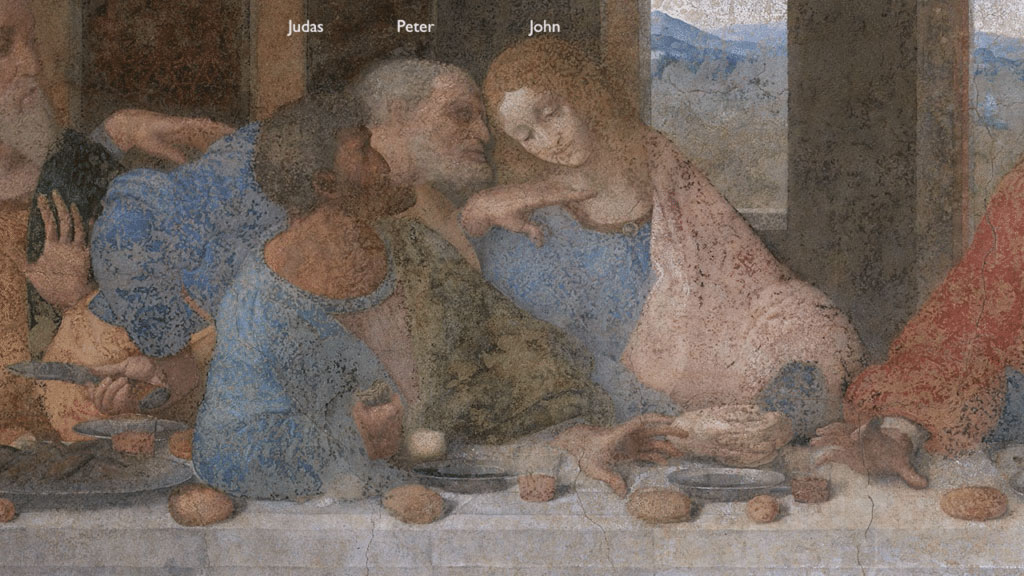
Hand gestures are an integral part of Masonic ritual and communication, conveying secret knowledge and recognition among initiates. The Sign of the Master Mason, the Due Guard, and the Penal Sign are among the most important hand gestures in Masonry, embodying the principles of loyalty, fidelity, and secrecy.
The hand gestures of the apostles in The Last Supper have been a source of fascination and debate for centuries. However, they also contain hidden Masonic symbolism. For example, the hand gesture of Thomas is a symbol of Masonic initiation, while the gesture Peter signifies fidelity and loyalty.
One of the most prominent hand gestures in the painting is the Sign of the Master Mason. This gesture involves placing the right hand over the left breast and then drawing it sharply across the body before letting it drop to the side. This gesture is said to represent the penalty for revealing the secrets of the Masonic order, which is death. In The Last Supper, this gesture can be seen in the figure of Judas Iscariot, who is depicted with his right hand over his left breast and his left hand clutching a bag of money.
Another hand gesture that appears in The Last Supper is the Due Guard. This gesture involves raising the right hand to the forehead with the palm facing outward, while the left hand is held behind the back. This gesture is used to demonstrate that one is a Master Mason and has been initiated into the secrets of the craft.
Finally, the painting also includes a depiction of the Penal Sign, which involves holding the hand in a particular position to signal distress or to request assistance from other Masons. In The Last Supper, this gesture can be seen in the figure of Peter, who is depicted with his right hand held up in a gesture of supplication.
6. The Square and Compass – The Tools of the Craft, the Emblem of the Master, and the Divine Proportion
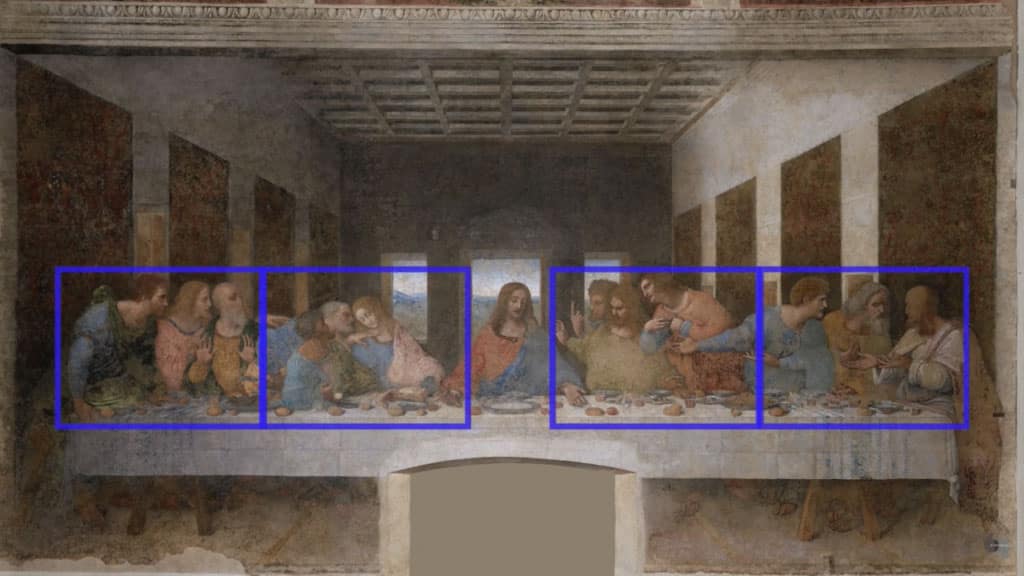
The Square and Compass is one of the most recognizable symbols in Freemasonry, representing the tools of the craft and the emblem of the Master. But this symbol holds much deeper meaning beyond its surface-level representation.
At its core, the Square and Compass represent the fundamental tools of the Masonic craft, used to shape and mold both physical and spiritual matter. The Square is used to test the correctness of angles, while the Compass is used to create perfect circles and arcs. These tools are used by Masons as a metaphor for the importance of precision, accuracy, and balance in both the physical and spiritual realms.
In addition to its practical use as a tool of the craft, the Square and Compass is also recognized as the emblem of the Master Mason, representing the culmination of a Mason’s journey through the degrees of the fraternity. This symbol is a reminder to Master Masons of their responsibility to act with wisdom, compassion, and humility, both within the fraternity and in the world at large.
Finally, the Square and Compass is also associated with the divine proportion, or the golden ratio. This proportion has been recognized since ancient times as a representation of divine harmony and balance, and is said to be embodied in the proportions of the human body, as well as in the design of the natural world. In Masonic teachings, this proportion is used as a symbol of the divine nature of the craft, and as a reminder of the importance of seeking balance and harmony in all aspects of life.
Together, the Square and Compass represent the cornerstone of Masonic teachings and represent the balance between morality and reason. In The Last Supper, the positioning of the apostles’ arms and hands creates a square and compass-like shape, further emphasizing the importance of these values.
In The Last Supper, some scholars have noted the presence of the Square and Compass symbol in the figure of Jesus Christ. In the painting, Jesus is depicted with his arms outstretched, forming a cross-like shape. His hands are also positioned in such a way as to suggest the Square and Compass, with one hand forming a square and the other a compass. This has been interpreted as a symbol of Jesus as the “Master of the Craft,” embodying the ideals of morality and spirituality that are central to Freemasonry.
The Square and Compass symbol also holds a special significance in Masonic teachings, as it represents the Divine Proportion or the ratio of 1:1.618. This ratio is found throughout nature and is considered by many to be a symbol of divine order and balance. In The Last Supper, the presence of the Square and Compass symbol may therefore, also be interpreted as a reference to the divine nature of Jesus Christ and his teachings.
7. The Skull and Crossbones – The Reminder of Mortality, the Symbol of Initiation, and the Sign of Immortality

The Skull and Crossbones is a potent symbol that evokes both fear and fascination, representing the transience of life, the ordeal of initiation, and the promise of immortality. It also symbolizes the Masonic legend of Hiram Abiff and his tragic death. In this section, we will explore the hidden meanings of the Skull and Crossbones and its role in Masonic ritual and lore.
At its core, the Skull and Crossbones is a reminder of mortality, serving as a visual representation of the inevitability of death. In Masonic teachings, this symbol is used to remind members of the fraternity that they must make the most of their time on earth, using their lives to make a positive impact on the world around them.
However, the Skull and Crossbones is not solely a symbol of death and decay. In fact, it is often used as a symbol of initiation, representing the idea that the end of one phase of life gives way to a new beginning. As Masons progress through the degrees of the fraternity, they are said to be reborn into a new understanding of themselves and the world around them.
Finally, the Skull and Crossbones is also a sign of immortality, representing the idea that death is not the end but rather a continuation of the journey towards enlightenment. In Masonic teachings, this symbol is often associated with the idea of the “hidden” or “secret” knowledge that can only be obtained through initiation and dedication to the craft.
In The Last Supper, some scholars have noted the presence of the Skull and Crossbones symbol in the figure of Judas Iscariot. Judas is depicted with a bag of silver coins in his hand, and his face is shadowed by a skull-like shape. This has been interpreted as a reference to the betrayal of Jesus, as well as a symbol of mortality and the fleeting nature of life.
However, the presence of the Skull and Crossbones symbol in The Last Supper may also reflect the influence of Freemasonry on Da Vinci’s work. In Masonic teachings, the Skull and Crossbones is a symbol of the degree of Knight Kadosh, which represents the ultimate sacrifice of one’s life for a noble cause. This interpretation adds a deeper layer of meaning to the painting, suggesting that the apostles and Jesus may be viewed as embodying the ideals of sacrifice and heroism that are central to Masonic teachings.
8. The Serpent – The Symbol of Wisdom, the Sign of Regeneration, and the Emblem of the Mysteries
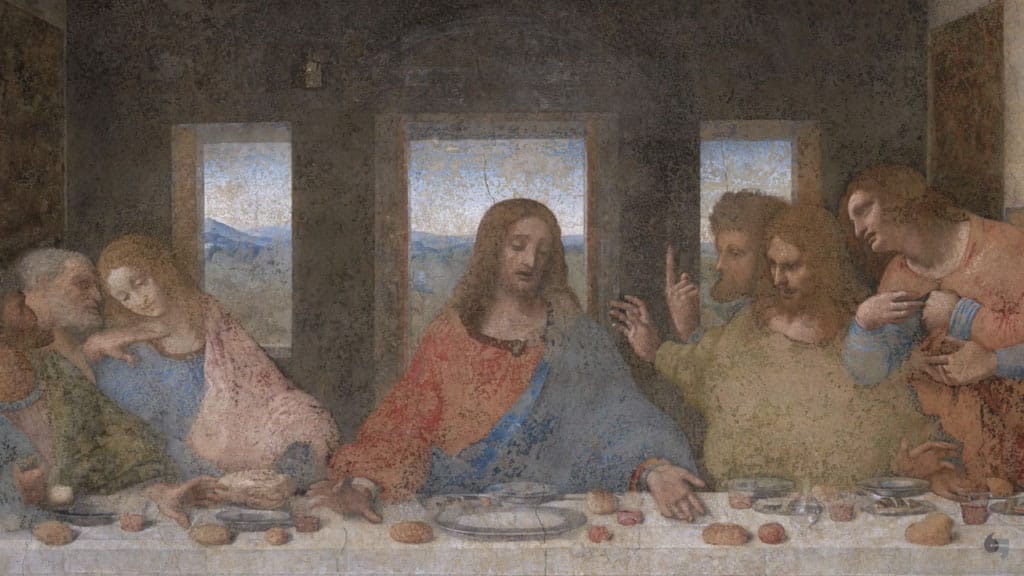
The serpent is an ancient symbol that has been used by numerous cultures and religions throughout history. In Freemasonry, the serpent holds a special significance, representing wisdom, regeneration, and the mysteries of the craft. The serpent also appears in one of the most famous works of art in history – The Last Supper by Leonardo da Vinci.
In The Last Supper, the serpent can be seen in the form of a winding path that appears to lead directly to Jesus. This path is believed to represent the journey toward enlightenment and spiritual transformation. It is also said to symbolize the serpent’s ability to shed its skin and emerge reborn, much like a Master Mason who undergoes initiation and ascends to higher degrees within the fraternity.
The presence of a serpent in artwork and symbolism often represents wisdom and knowledge, which is no exception in Masonic teachings. In fact, the serpent is one of the most significant symbols in Freemasonry, representing not only the pursuit of knowledge but also the regeneration and renewal of life.
In the context of The Last Supper painting, the presence of the serpent is not immediately obvious, but it can be seen in the position of Jesus’ arm. His right arm is extended towards the bread, while his left arm is extended towards the wine, forming a subtle “S” shape that suggests the presence of a serpent.
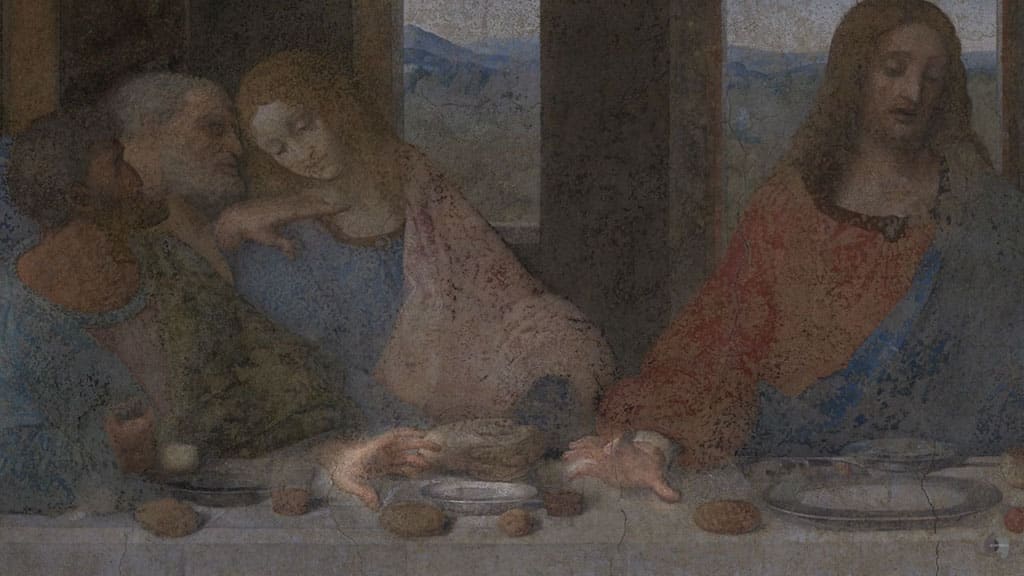
This imagery is reminiscent of the serpent in the Garden of Eden, where it represents the temptation of knowledge and the fall of man. However, in Masonic symbolism, the serpent is not associated with evil or sin, but rather with the pursuit of wisdom and the regeneration of the soul.
In Masonic ritual, the serpent is often represented by the image of a serpent eating its own tail, known as the Ouroboros. This symbolizes the cyclical nature of life and death, as well as the endless pursuit of knowledge and enlightenment.
The presence of the serpent in The Last Supper painting reinforces the idea that the painting is imbued with Masonic influences and symbolism. It suggests that the pursuit of knowledge and the regeneration of the soul are central themes in both Freemasonry and the painting itself.
Overall, the serpent is a powerful symbol that represents both the pursuit of knowledge and the regeneration of the soul in Masonic teachings. Its presence in The Last Supper painting adds another layer of complexity and meaning to an already rich and intriguing work of art.
9. Tau Cross – A significant emblem of Freemasonry, and its presence in The Last Supper painting by Leonardo da Vinci.

The Tau Cross is an ancient symbol that has been associated with various meanings across cultures and religions. In Freemasonry, The Tau Cross holds a special place as a significant emblem that represents the order’s principles and values. The cross’s unique shape has led to a range of interpretations, including its resemblance to the Greek letter Tau and its connection to the Egyptian god Osiris.
One of the most intriguing representations of The Tau Cross is its presence in The Last Supper painting by Leonardo da Vinci. The painting has been studied and analyzed for centuries, and its inclusion of The Tau Cross has been a topic of debate and fascination. In this blog post, we will delve into the history and symbolism of The Tau Cross and its presence in The Last Supper.
The History of The Tau Cross:
The Tau Cross has a long history dating back to ancient times. The symbol was used by the Egyptians to represent their god Osiris and was associated with the concept of rebirth and resurrection. In Greek, the symbol is known as the letter Tau and was used to represent the word “tav,” meaning “mark” or “sign.”
In Christianity, The Tau Cross has been associated with the Franciscan order, where it was used as a symbol of humility and simplicity. Saint Francis of Assisi was known for using The Tau Cross as his personal emblem, and his followers would also wear the cross as a sign of their devotion.
In Freemasonry, The Tau Cross has been used to represent the order’s principles of truth, honor, and virtue. The symbol is often associated with the concept of regeneration and represents the journey of the individual from darkness to light.
The Last Supper and The Tau Cross:
The Last Supper is one of the most famous paintings in history and has been the subject of much scrutiny and analysis. The painting depicts Jesus Christ and his twelve apostles during their last meal before his crucifixion. The painting’s composition and symbolism have led to numerous interpretations and theories.
One of the most intriguing aspects of The Last Supper is the presence of The Tau Cross. The cross is visible in the center of the painting, behind Jesus, and is formed by the intersection of the table and the wall. Some scholars have suggested that Leonardo da Vinci included The Tau Cross as a nod to the Franciscan order’s use of the symbol.
Others have suggested that The Tau Cross represents the concept of regeneration and rebirth, as it does in Freemasonry. The cross’s presence behind Jesus may symbolize his role as the redeemer and his journey from death to resurrection.
10. The Sun and Moon – The Symbols of Light and Darkness, the Emblems of the Craft, and the Keys to the Mysteries

The Sun and Moon are among the most powerful symbols in Freemasonry, representing the duality of light and darkness, and the balance between them. These celestial bodies have been used in the craft for centuries and are found throughout Masonic symbolism, including in the painting of The Last Supper.
In Masonic teachings, the Sun represents light, knowledge, and truth. It is the source of illumination that allows Masons to see the world in a different way and to understand the mysteries of the craft. The Sun is often associated with the masculine, active principle, and is represented by a five-pointed star with a dot in the center, known as the blazing star.
The Moon, on the other hand, represents darkness, mystery, and the feminine, receptive principle. It is associated with the unconscious mind, intuition, and the hidden aspects of reality. The Moon is often depicted as a crescent shape, with the horns pointing upward, and is sometimes accompanied by stars, symbolizing the heavens.
The Sun and Moon are universal symbols that represent the dual nature of existence, the interplay of light and darkness, and the cycles of life and death. In Masonic symbolism, the Sun and Moon are associated with the pillars of the Lodge, the emblems of the craft, and the keys to the mysteries.
The sun and moon, which can be seen in the triangular window above Jesus’ head, are symbols used in both Christian and Masonic teachings to represent the duality of life and the balance of opposing forces.
In The Last Supper, the Sun and Moon can be seen in the background, flanking Jesus at the center of the table. The Sun is on the left, with its rays emanating outward, while the Moon is on the right, with its horns pointing upward. This placement suggests the balance between light and darkness and the importance of maintaining equilibrium in all aspects of life.
Furthermore, the Sun and Moon can be seen as emblems of the craft, representing the two pillars of the Masonic temple: Boaz and Jachin. These pillars symbolize strength and stability and are associated with the Sun and Moon, respectively.
11: Bread and Wine in Masonic Teachings: Symbols of Spiritual Nourishment and Enlightenment
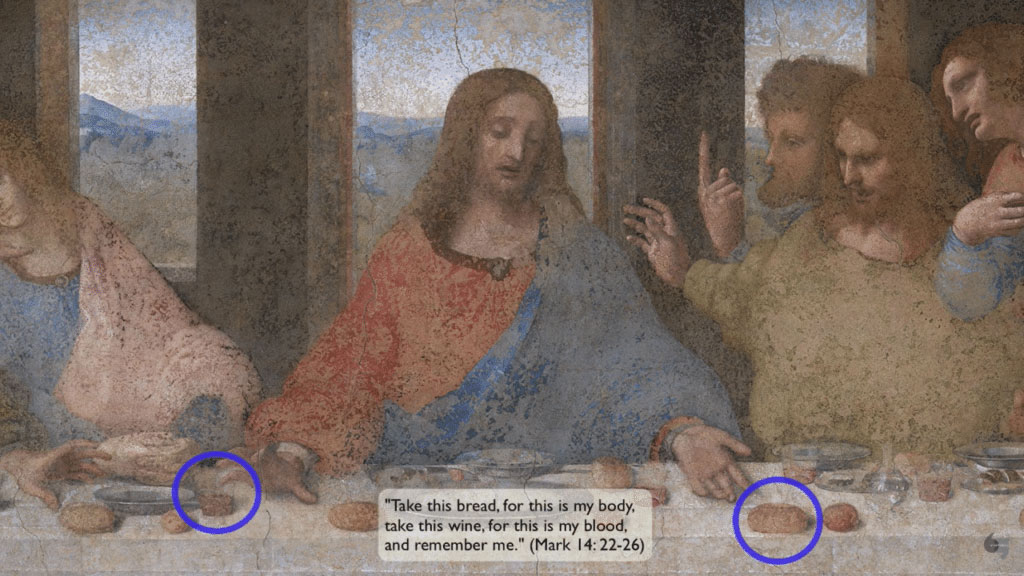
In Masonic teachings, bread and wine are two important symbols that represent spiritual nourishment and enlightenment. These symbols have a rich history and deep meaning within the Masonic tradition, and they serve as powerful reminders of the importance of spiritual growth and development for Masons.
The symbolism of bread and wine can be traced back to the Christian sacrament of the Eucharist, which commemorates the Last Supper of Jesus Christ with his disciples. In this sacrament, bread, and wine are used to represent the body and blood of Christ and are consumed by the faithful as a way of symbolically partaking in his sacrifice and receiving spiritual nourishment.
In The Last Supper, the bread is represented by the three loaves on the table, which symbolize the Holy Trinity in Christian tradition. The wine is represented by the chalice, which Jesus holds in his hand and which is commonly associated with the Grail in legend and lore.
In Masonic teachings, bread and wine are used in a similar way, but with a broader meaning that encompasses all spiritual seekers, regardless of their religious beliefs. The bread represents the nourishment that the soul needs to grow and flourish, while the wine represents the spiritual enlightenment that comes from seeking truth and wisdom.
By using these symbols, Masonic teachings emphasize the importance of spiritual growth and development and encourage Masons to seek out knowledge and wisdom in order to nourish their souls and achieve enlightenment. The symbols of bread and wine serve as powerful reminders of these values, and of the enduring legacy of Freemasonry as a source of spiritual guidance and moral support for its members.
For Masons, the bread and wine in The Last Supper also represent the concept of sacrifice. Just as Jesus sacrificed himself for the greater good, Masons are taught to sacrifice their own desires and passions in service to a higher purpose.
12: The Five-Pointed Star in Freemasonry: Unveiling Its Significance

In Freemasonry, the five-pointed star is a symbol of great significance. Also known as the pentagram or pentacle, it is a symbol that has been used by many different cultures and traditions throughout history. In Freemasonry, the five-pointed star is often used to represent the five points of fellowship, which are the foot, knee, breast, hand, and cheek.
Each of these points is associated with a particular obligation or commitment that Masons make to each other as part of their initiation into the order.
- The foot represents Mason’s willingness to go wherever he is needed to assist his brothers.
- The knee represents Mason’s willingness to kneel in prayer and supplication, both for himself and for his brothers.
- The breast represents Mason’s commitment to keep the secrets and obligations of the order close to his heart and to protect his brothers from harm.
- The hand represents a Mason’s willingness to extend his hand in friendship and brotherhood to all other Masons, regardless of their station or background.
- The cheek represents a Mason’s willingness to listen to the concerns and needs of his brothers, and to offer support and encouragement when needed.
The Last Supper painting by Leonardo da Vinci features a subtle reference to the five-pointed star, a symbol with various meanings and interpretations in different cultures and contexts. In the painting, the star can be found on the robe of Jesus Christ, right above his heart. It can also be found on the forehead of Judas Iscariot, who is sitting to the right of Jesus.
In Freemasonry, the pentagram is a symbol that represents a variety of concepts, including the five points of fellowship, the five senses, and the five elements. It is also associated with the concept of the divine, with each point representing a different aspect of the universe.
The placement of the pentagram in the Last Supper painting suggests that it is imbued with Masonic influences and adds another layer of meaning to the painting. Some interpretations suggest that the pentagram represents the divine nature of Christ, while others suggest that it represents the importance of brotherhood and unity among the disciples.
It is worth noting that the use of the pentagram in Freemasonry has been the subject of controversy and debate, with some individuals associating the symbol with negative connotations such as black magic and Satanism. However, within the context of the Last Supper painting, the pentagram appears to have a positive and uplifting meaning, highlighting the importance of brotherhood and spiritual unity.
13: The Hidden “M” Symbol in The Last Supper
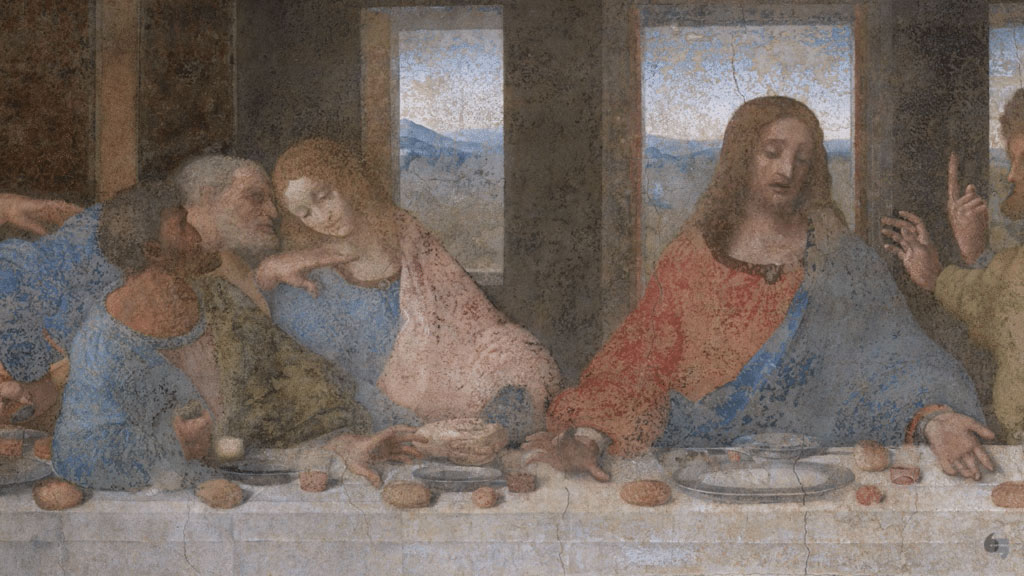
One of the lesser-known hidden symbols in The Last Supper is the letter “M” which can be seen in the position of the apostles’ hands and arms, forming an “M” shape. While this symbol may be easy to overlook, it holds great significance in both Christian and Masonic traditions.
In Christian teachings, the letter “M” is often associated with the Virgin Mary, who is revered as the mother of Jesus Christ. In many depictions of the Virgin Mary, she is shown wearing a cloak with an “M” on it, symbolizing her role as the mother of the Messiah. In The Last Supper, the presence of the “M” symbol may be seen as a subtle reference to the importance of Mary in the Christian tradition.
In Masonic teachings, the letter “M” is also significant, representing a range of different concepts depending on the context in which it is used. Some Masonic scholars have suggested that the “M” in The Last Supper may represent the Masonic term “Master”, which is used to refer to the highest degree in the Masonic order.
Overall, the hidden “M” symbol in The Last Supper serves as a reminder of the complex layers of symbolism and meaning that can be found in works of art and literature. It also underscores the ongoing importance of symbolism and ritual in both Christian and Masonic traditions and highlights the enduring influence of these traditions on art and culture over time.
In conclusion, The Last Supper is a rich and complex work of art that contains numerous hidden symbols and references to Masonic teachings. From the use of the Letter “G” to the presence of the Five-Pointed Star, each symbol adds depth and meaning to the painting and invites viewers to explore the connections between art, symbolism, and spirituality. The inclusion of the Letter “M” symbol in the painting highlights the influence of Masonic teachings on Da Vinci’s work and serves as a reminder of the lasting impact of Freemasonry on Western culture and art.
